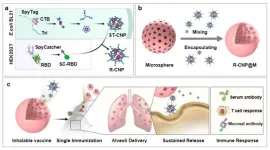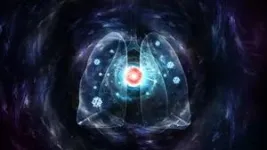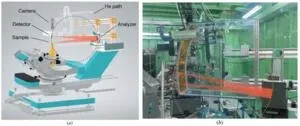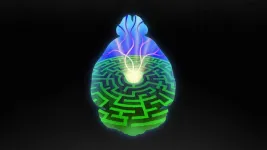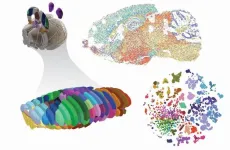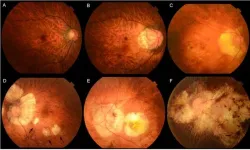(Press-News.org)
Researchers from the Institute of Process Engineering (IPE) of the Chinese Academy of Sciences have proposed a new “nano-micro composite” delivery concept for vaccines. Based on this idea, they have developed a single-dose, dry-powder, inhalable vaccine platform using nano-micro composite multilevel structures, which has been successfully prepared in the laboratory, and the vaccine has been shown to be effective in blocking respiratory viral infection and transmission in animal models. This platform holds great promise for combating future emerging and epidemic infectious diseases.
This study was published in Nature on Dec 13.
In recent years, researchers have made significant progress in developing vaccines for infectious respiratory diseases. However, most of these vaccines are administered through intramuscular injection, which primarily induces a humoral immune response and relies on blood antibodies to neutralize the virus. Unfortunately, this approach fails to trigger a mucosal immune response and establish a robust immune barrier in the respiratory tract.
Moreover, adjuvants commonly used in current vaccines, e.g., aluminum adjuvants, are unable to induce cellular immune responses and are ineffective in combating rapid viral mutations. Additionally, the current liquid form of vaccines necessitates strict low-temperature storage conditions, and the two- or three-dose vaccination schedule also impacts the overall vaccination rate.
To address these problems, interdisciplinary integration and innovative research concepts are needed to develop safer and more efficient vaccines for respiratory infections.
Taking this approach, Prof. WEI Wei and Prof. MA Guanghui, from the State Key Laboratory of Biochemical Engineering at IPE, in cross-disciplinary collaboration with Prof. WANG Hengliang and Prof. ZHU Li, from the State Key Laboratory of Pathogen and Biosecurity, have developed a new vaccine platform to tackle these challenges.
This platform combines biodegradable microspheres with protein nanoparticles. The surface of these nanoparticles can simultaneously display multiple antigens, thus inducing a broad-spectrum immune response and expanding the range of vaccine protection. It also allows for the quick and convenient development of other respiratory virus vaccines due to the flexibility of antigen presentation.
Moreover, the platform’s unique nano-micro composite structure enables an efficient immune response in the lungs by facilitating high-performance delivery. Once the antigen-nanoparticles are released, they can be efficiently taken up by antigen-presenting cells.
Additionally, this dry powder vaccine significantly reduces storage and transportation costs, making it suitable for areas with limited refrigeration facilities, thus improving immunization rates.
Furthermore, the sustained release of antigens in the vaccine induces long-lasting humoral, cellular, and mucosal immunity with just a single inhalation. In later cooperation with Prof. HE Zhanlong of the Institute of Medical Biology of the Chinese Academy of Medical Sciences, the researchers developed a model of airborne protection, close contact protection, and airborne transmission blocking, which described the benefits of inhaled vaccine for preventing the virus infection and transmission.
“The components of this nano-micro system used natural proteins and approved polymer materials, and the effectiveness and safety of the vaccine have been systematically studied in non-human primates, indicating its great potential for clinical translation.” said Prof. WEI Wei.
END
Cannabis use for medicinal or recreational purposes is now permitted is most states in the U.S. Many of the products sold in dispensaries contain delta-9-tetrahydrocannabinol (better known as “THC”), and are thus classified as Schedule I drugs, making them illegal under federal law.
However, there is a parallel market for products derived from hemp—defined as cannabis containing less that 0.3 percent THC—spurred in part by the passage of the 2018 Farm Bill, which removed hemp-derived cannabinoids from the federal Controlled Substances Act.
A new U-M study published in JAMA Network Open examines past-year use of some of these hemp-derived ...
PHILADELPHIA— New research reveals that neurons in the preoptic hypothalamus—the region of the brain that regulates sleep and body temperature—are rhythmically activated during non-rapid eye movement sleep (NREM). Stress activates these brain cells out of turn, causing “microarousals,” that interrupt sleep cycles and decrease the duration of sleep episodes, according to research from Perelman School of Medicine at the University of Pennsylvania, published today in Current Biology.
While our bodies are at rest when we are asleep, ...
By Jake Siegel
Imagine you’re teaching a dog to play fetch. You throw a ball, and your dog sprints after it, picks it up, and runs back. You then reward your panting pup with a treat. But now comes the real trick for your dog: figuring out which part of that sequence earned the treat. Scientists call this the 'credit assignment problem' in the brain. It's a fundamental question about understanding which actions are responsible for the positive outcomes we experience.
Dopamine, a key chemical ...
LA JOLLA (December 14, 2023)—Salk Institute researchers, as part of a worldwide initiative to revolutionize scientists’ understanding of the brain, analyzed more than 2 million brain cells from mice to assemble the most complete atlas ever of the mouse brain. Their work, published December 14, 2023 in a special issue of Nature, not only details the thousands of cell types present in the brain but also how those cells connect and the genes and regulatory programs that are active in each cell.
The efforts were coordinated by the National Institutes of Health’s Brain Research Through Advancing Innovative Neurotechnologies® Initiative, or the BRAIN Initiative®, ...
By Jake Siegel
Six years and 32 million cells later, scientists have created the first full cellular map of a mammalian brain. In a set of 10 papers in Nature today, a network of researchers unveiled an atlas cataloging the location and type of every cell in the adult mouse brain. Using advanced technologies that profile individual cells, the teams identified over 5,300 cell types – far more than known before – and pinpointed their locations within the brain’s intricate geography. ...
SAN FRANCISCO—December 13, 2023—In a study of historic scale, scientists at Gladstone Institutes have created an intricate map of how the immune system functions, examining the detailed molecular structures governing human T cells using the next-generation CRISPR tool known as base editing.
Their findings, published in Nature, uncover detailed information that could help overcome the limitations of today’s immunotherapies and identify new drug targets for a wide range of diseases, including autoimmune diseases and cancer.
Led by Gladstone Senior Investigator Alex Marson, MD, PhD, the team dove deep into the DNA of T cells, pinpointing ...
Liquid crystal is a state of matter that exhibits properties of both liquid and solid. It can flow like a liquid, while its constituent molecules are aligned as in a solid. The liquid crystal is widely used nowadays, for example, as a core element of LCD devices. The magnetic analog of this kind of material is dubbed the “spin-nematic phase”, where spin moments play the role of the molecules. However, it has not yet been directly observed despite its prediction a half-century ago. The main challenge stems ...
COLUMBUS, Ohio – Scientists have revealed a never-before-seen phenomenon in a protein: Alone, the enzyme processes DNA and RNA but, when bound to another protein as part of a defense system, interacts with a completely different type of compound to help bacteria commit suicide.
The finding came about as the researchers focused on detailing how this defense mechanism works in bacteria that are infected by phages, viruses that invade and make copies of themselves inside bacterial cells. In addition to detailing the proteins’ structures and binding sites, the experiments unearthed ...
Researchers from Tokyo Medical and Dental University (TMDU) develop models based on machine learning that predict long-term visual acuity in patients with high myopia, one of the top three causes of irreversible blindness in many regions of the world
Tokyo, Japan – Machine learning has been found to predict well the outcomes of many health conditions. Now, researchers from Japan have found a way to predict whether people with severe shortsightedness will have good or bad vision in the future.
In a study recently published in ...
For the first time ever, an international team of researchers has created a complete cell atlas of a whole mammalian brain. This atlas serves as a map for the mouse brain, describing the type, location, and molecular information of more than 32 million cells and providing information on connectivity between these cells. The mouse is the most commonly used vertebrate experimental model in neuroscience research, and this cellular map paves the way for a greater understanding of the human brain—arguably the most powerful computer in the world. The cell atlas also lays the foundation for the development of a new generation of precision therapeutics for people ...
